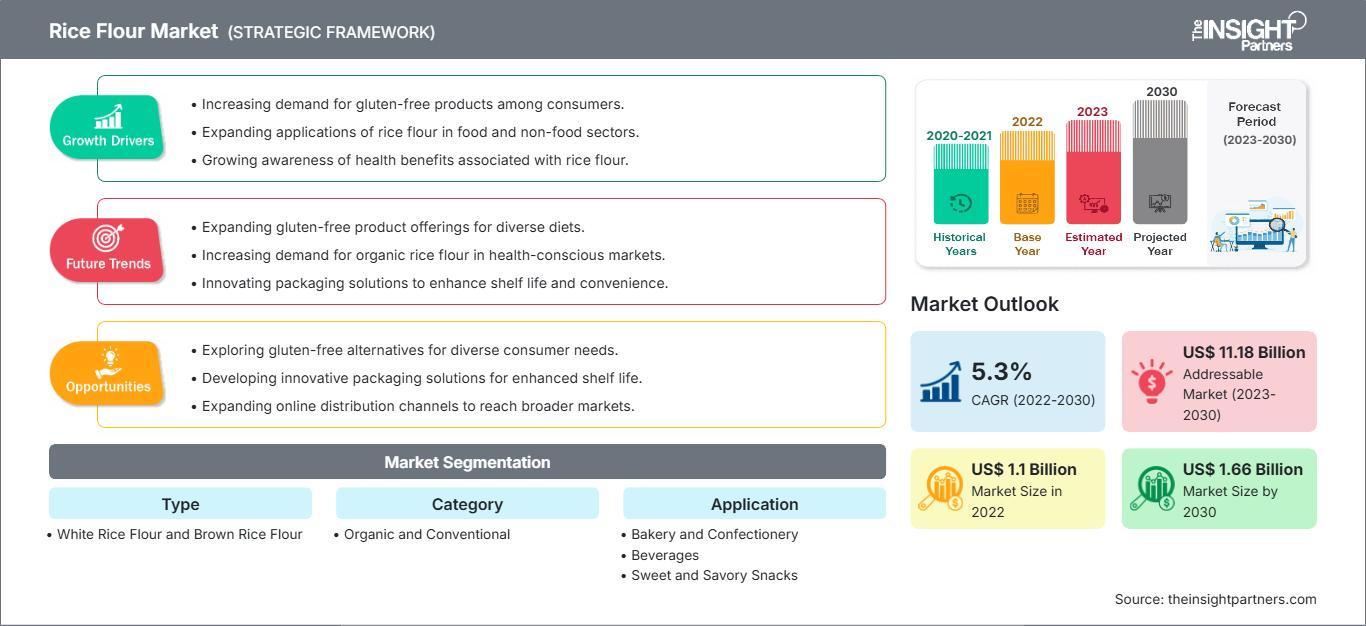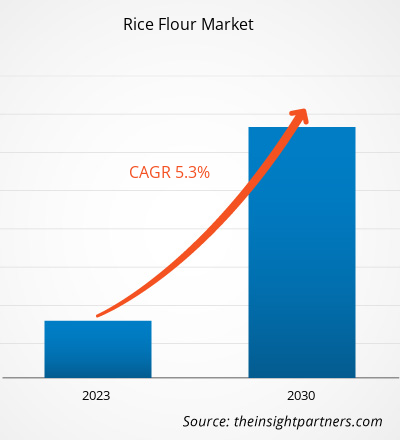[연구 보고서] 쌀가루 시장 규모는 2022년 11억 47만 달러로 평가되었으며, 2030년에는 16억 5,582만 달러에 이를 것으로 예상됩니다. 2023년부터 2030년까지 연평균 성장률 5.3%를 기록할 것으로 예상됩니다.
시장 분석 및 분석가 의견:
쌀가루는 쌀알을 굵은 가루와 고운 가루로 분쇄하여 만듭니다. 쌀가루는 글루텐이 없어 밀가루 대체재로 사용됩니다. 소비자들의 건강 우려 증가와 글루텐 프리 식단에 대한 수요 증가는 쌀가루 시장 성장을 촉진하고 있습니다. 쌀가루는 소화관 개선, 골격 건강 증진, 상처 치유 촉진, 셀리악 환자에게 유익한 등 다양한 건강상의 이점을 제공합니다. 쌀가루는 비타민 C가 풍부하고 피부 회복에 필요한 항산화제를 함유하고 있습니다. 현미는 비타민 B, 고단백, 그리고 더 많은 섬유질과 항산화제를 함유하고 있는 반면, 백미는 빈 칼로리가 풍부합니다. 쌀의 영양학적 이점은 다양한 식음료 제조업체의 쌀가루 수요를 증가시킵니다. 쌀가루는 제빵 및 과자, 달콤하고 짭짤한 간식, 음료, 이유식 등 다양한 식품에 사용되는 건강한 재료입니다. 쌀가루는 중간 크기, 단립종, 장립종, 젤라틴화 쌀가루의 세 가지 종류로 판매됩니다.
성장 동력과 과제:
쌀가루는 제빵 및 과자, 달콤하고 짭짤한 간식, 음료, 이유식 등 다양한 식품에 사용되는 건강한 재료입니다. 쌀가루는 중간 크기, 단립종, 장립종, 젤라틴화 쌀가루의 세 가지 종류로 판매됩니다. 쌀가루는 비타민 C가 풍부하고 피부 회복에 필요한 항산화제를 함유하고 있습니다. 현미는 비타민 B, 고단백, 그리고 더 많은 섬유질과 항산화제를 함유한 쌀가루의 한 종류인 반면, 백미는 빈 칼로리가 풍부합니다. 쌀의 영양학적 이점은 다양한 식음료 제조업체의 쌀가루 수요를 증가시킵니다. 쌀가루에는 동물과 인간에게 필수적인 영양소인 콜린이 함유되어 있습니다. 콜린은 간에서 체내로 콜레스테롤과 중성지방을 운반하는 데 도움을 줍니다. 따라서 간 건강 유지에 도움이 되는 것으로 알려져 있습니다. 쌀가루는 칼슘 함량이 풍부하여 100g당 10mg의 칼슘을 함유하고 있어 뼈 건강 유지에 도움이 됩니다. 우유, 치즈, 두부, 견과류 등 칼슘이 풍부한 다른 식품과 함께 섭취하면 일일 권장 섭취량을 유지하는 데 도움이 됩니다. 따라서 소비자들 사이에서 쌀가루의 영양학적 이점에 대한 인식이 높아지면서 쌀가루 시장이 성장하고 있습니다. 쌀가루는 다양한 식음료 제조에 사용되는 주요 원료이자 원자재입니다. 쌀과 같은 원자재 공급망에 차질이 생기면 결국 쌀가루 가격이 상승하게 됩니다. 공급 변동은 날씨, 작물 질병, 해충, 정치·사회적 불안, 노동력 부족 등 여러 요인으로 인해 발생할 수 있습니다. 또한 제조업체들은 증가하는 수요를 충족하기 위해 장립종 쌀을 불합리한 가격에 제분하여 쌀가루를 생산하고 있습니다. 이러한 요인들은 급격한 가격 상승으로 이어집니다. 쌀가루 시장의 주요 과제 중 하나는 기후 변화로 인한 곡물 가격의 예측 불가능성입니다. 기후 변동성과 계절적 변동은 작물에 큰 영향을 미쳐 다양한 지역의 작물 수확량을 감소시키고, 궁극적으로는 생산 투입량과 가격 차이를 초래합니다. 예를 들어, 장기간의 가뭄은 쌀 재배에 지장을 초래합니다. 또한, 작물 가격 변동은 에너지, 화학 물질, 비료 비용의 변동으로 인해 발생합니다. 쌀 가격 변동은 원자재 가격이 자주 변동하기 때문에 새로운 현상이 아닙니다. 그러나 현재의 쌀 수요 증가와 쌀 공급 차질 또는 부족은 쌀가루 가격에 큰 영향을 미쳐 시장 성장을 저해할 수 있습니다.
이 보고서의 일부, 국가 수준 분석, Excel 데이터 팩을 포함하여 모든 보고서에 대한 사용자 정의를 무료로 받을 수 있을 뿐만 아니라 스타트업 및 대학을 위한 훌륭한 제안 및 할인을 이용할 수 있습니다
쌀가루 시장: 전략적 통찰력

- 이 보고서의 주요 주요 시장 동향을 확인하세요.이 무료 샘플에는 시장 동향부터 추정 및 예측에 이르기까지 데이터 분석이 포함됩니다.
세계 쌀가루 시장은 유형, 범주, 용도 및 지역별로 세분화됩니다. 쌀가루 시장은 유형에 따라 백미가루와 현미가루로 구분됩니다. 쌀가루 시장은 범주별로 유기농 및 일반 쌀가루로 분류됩니다. 용도별로는 제빵 및 제과, 음료, 달콤하고 짭짤한 간식, 이유식, 아침 시리얼 등으로 세분화됩니다. 세계 쌀가루 시장은 지역별로 북미, 유럽, 아시아 태평양, 중동 및 아프리카, 중남미로 크게 세분화됩니다.
세분화 분석:
유형별로 쌀가루 시장은 백미가루와 현미가루로 구분됩니다. 현미가루 부문은 예측 기간 동안 더 높은 CAGR을 기록할 것으로 예상됩니다. 백미가루와 달리 현미가루는 통밀 현미로 만들어져 겨층과 배아층을 그대로 유지합니다. 따라서 현미가루는 백미가루보다 섬유질, 비타민, 미네랄, 항산화 성분이 풍부합니다. 통곡물의 영양적 이점에 대한 인식이 높아지고 더 건강한 식품을 찾는 수요가 증가함에 따라 현미가루 수요가 증가하고 있습니다. 현미는 자연적으로 글루텐이 없어 밀가루 대신 글루텐 없는 베이킹과 요리에 사용할 수 있습니다. 또한, 건강한 생활 방식의 일환으로 통곡물과 최소 가공 재료에 대한 관심이 높아지고 있습니다. 통곡물 제품인 현미가루는 이러한 추세에 발맞춰 소비자들은 정제된 밀가루보다 영양가가 높은 현미가루를 선호할 수 있습니다. 또한, 현미가루는 밀, 콩, 유제품, 견과류와 같은 일반적인 알레르기 유발 물질을 함유하지 않아 여러 식품 알레르기나 민감증이 있는 사람들에게 적합합니다. 또한, 현미가루는 제빵, 조리, 소스 걸쭉하게 만들기 등 다양한 요리에 사용할 수 있습니다. 현미분은 요리법에 고소한 풍미와 더 진한 식감을 더하여 요리의 맛을 한층 더 풍부하게 합니다. 이러한 모든 요인들이 현미분 시장 성장을 촉진하고 있습니다.
지역 분석:
현미분 시장은 지리적으로 북미, 유럽, 아시아 태평양, 중남미, 중동 및 아프리카의 5개 주요 지역으로 나뉩니다. 아시아 태평양 지역이 세계 쌀분 시장을 주도했으며, 2022년 시장 규모는 4억 3,544만 달러였습니다. 북미는 세계 시장 점유율 28% 이상을 차지하는 두 번째 주요 지역입니다. 북미는 예측 기간 동안 연평균 성장률 6% 이상의 상당한 성장을 기록할 것으로 예상됩니다. 북미는 미국, 캐나다, 멕시코와 같은 강세 및 선진 경제 국가로 구성된 주요 지역 중 하나입니다. 제빵 산업은 북미에서 가장 중요한 산업 중 하나이며, 제빵 제품은 주식으로 간주됩니다. 미국 제빵협회에 따르면 미국 제빵 산업의 연평균 매출은 1,540억 달러입니다. 바쁜 생활 방식과 간편식에 대한 선호도 증가로 쿠키, 케이크, 페이스트리, 머핀 및 기타 제빵 제품에 대한 수요도 증가하고 있습니다. 제빵 산업은 쌀가루의 주요 최종 사용자 중 하나이므로 쌀가루 시장은 향후 몇 년 동안 성장할 것으로 예상됩니다.
산업 발전 및 미래 기회:
인조 속눈썹 시장에서 활동하는 주요 기업들이 취한 다양한 사업은 다음과 같습니다.
- 2023년 4월, 한국 농림축산식품부(MAFRA)는 15개의 주요 국내 식음료 기업과 협력하여 국가 "쌀 제품 개발 사업"의 다음 단계로 나아갔습니다. 농식품부는 올해 쌀 기반 신제품 19종을 개발할 계획이라고 밝혔다.
쌀가루 시장
The Insight Partners의 분석가들은 예측 기간 동안 쌀가루 시장에 영향을 미치는 지역별 동향과 요인들을 면밀히 분석했습니다. 이 섹션에서는 북미, 유럽, 아시아 태평양, 중동 및 아프리카, 그리고 중남미 지역의 쌀가루 시장 세분화 및 지역별 분포도 살펴봅니다.
쌀가루 시장 보고서 범위
| 보고서 속성 | 세부 |
|---|---|
| 시장 규모 2022 | US$ 1.1 Billion |
| 시장규모별 2030 | US$ 1.66 Billion |
| 글로벌 CAGR (2022 - 2030) | 5.3% |
| 이전 데이터 | 2020-2021 |
| 예측 기간 | 2023-2030 |
| 다루는 세그먼트 |
By 종류
|
| 포함된 지역 및 국가 | 북미
|
| 시장 선도 기업 및 주요 회사 프로필 |
|
쌀가루 시장 참여자 밀도: 비즈니스 역학에 미치는 영향 이해
쌀가루 시장은 소비자 선호도 변화, 기술 발전, 그리고 제품의 효능에 대한 인식 제고 등의 요인으로 최종 사용자 수요가 증가함에 따라 빠르게 성장하고 있습니다. 수요가 증가함에 따라 기업들은 제품 라인업을 확장하고, 소비자 니즈를 충족하기 위한 혁신을 추진하며, 새로운 트렌드를 적극 활용하고 있으며, 이는 시장 성장을 더욱 가속화하고 있습니다.

- 을 얻으세요 쌀가루 시장 주요 주요 플레이어 개요
코로나19 팬데믹은 제조 시설 폐쇄, 노동력 부족, 공급망 차질, 금융 불안정 등으로 인해 세계 쌀가루 시장에 초기에 영향을 미쳤습니다. 코로나19 발생으로 인한 경기 침체로 여러 산업이 차질을 빚으면서 쌀가루 수요가 위축되었습니다. 그러나 여러 국가에서 이전에 시행되었던 제한 조치가 완화되면서 기업들은 다시 성장세를 보이고 있습니다. 또한, 각국 정부의 코로나19 백신 접종으로 상황이 완화되면서 전 세계적으로 사업 활동이 증가했습니다. 봉쇄와 이동 제한이 완화되면서 쌀가루 시장을 포함한 여러 시장이 성장을 보였습니다.
경쟁 환경 및 주요 기업:
글로벌 가짜 속눈썹 시장에서 활동하는 주요 기업으로는 PGP International Inc, Ebro Foods SA, Western Foods LLC, Ingredion Inc, CAREMOLI SpA, BELOURTHE SA, Kroner-Starke GmbH, Capitol Food Co, Ardent Mills LLC, Bay State Milling Co, Bob's Red Mill Natural Foods Inc, Gulf Pacific Rice Co Inc, Naturis SpA, Hometown Food Co, Koda Farms Inc, Archer-Daniels-Midland Co 등이 있습니다.
- 과거 분석(2년), 기준 연도, CAGR을 포함한 예측(7년)
- PEST 및 SWOT 분석
- 시장 규모 가치/거래량 - 글로벌, 지역, 국가
- 산업 및 경쟁 환경
- Excel 데이터세트
최근 보고서
사용 후기
구매 이유
- 정보에 기반한 의사 결정
- 시장 역학 이해
- 경쟁 분석
- 고객 인사이트
- 시장 예측
- 위험 완화
- 전략 기획
- 투자 타당성 분석
- 신흥 시장 파악
- 마케팅 전략 강화
- 운영 효율성 향상
- 규제 동향에 발맞춰 대응






















 무료 샘플 받기 - 쌀가루 시장
무료 샘플 받기 - 쌀가루 시장